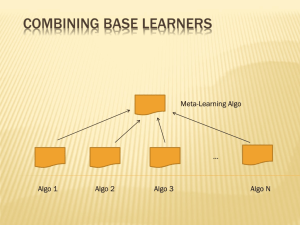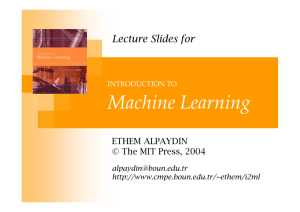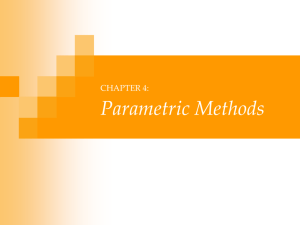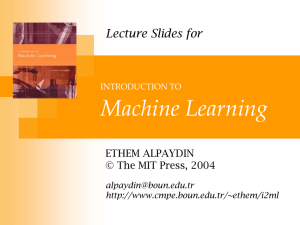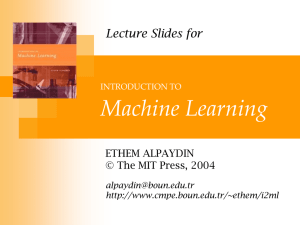9-i2ml-chap15-classifier-combination
advertisement
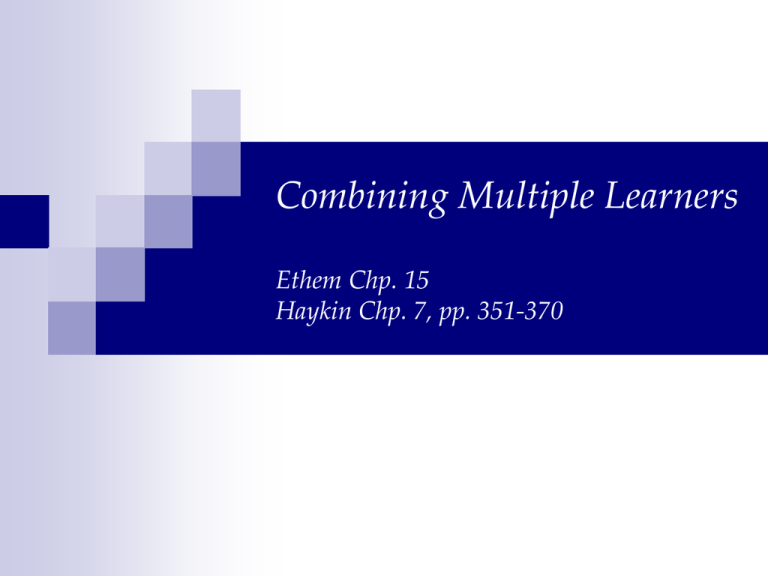
Combining Multiple Learners Ethem Chp. 15 Haykin Chp. 7, pp. 351-370 Overview Introduction Rationale Combination Methods Static Structures Ensemble averaging (Sum,Product,Min rule) Bagging Boosting Error Correcting Output Codes Dynamic structures Mixture of Experts Hierarchical Mixture of Experts 2 Lecture Notes for E Alpaydın 2004 Introduction to Machine Learning © The MIT Press (V1.1) Motivation When designing a learning machine, we generally make some choices: parameters of machine, training data, representation, etc… This implies some sort of variance in performance Why not keep all machines and average? ... 3 Lecture Notes for E Alpaydın 2004 Introduction to Machine Learning © The MIT Press (V1.1) Rationale No Free Lunch thm: “There is no algorithm that induces the most accurate learner in any domain, all the time.” http://www.no-free-lunch.org/ Generate a group of base-learners which when combined has higher accuracy Different learners use different Algorithms: making different assumptions Hyperparameters: e.g number of hidden nodes in NN, k in k-NN Representations: diff. features, multiple sources of information Training sets: small variations in the sets or diff. subproblems 4 Lecture Notes for E Alpaydın 2004 Introduction to Machine Learning © The MIT Press (V1.1) Reasons to Combine Learning Machines d1 d2 input d3 Final output d4 d5 Lots of different combination methods: Most popular are averaging and majority voting. Intuitively, it seems as though it should work. We have parliaments of people who vote, and that works … We average guesses of a quantity, and we’ll probably be closer… 5 Lecture Notes for E Alpaydın 2004 Introduction to Machine Learning © The MIT Press (V1.1) Some theory > Reasons to Combine Learning Machines f com vote( f i , f j , f k , f l , f m ) Probability of error in case of voting is all the combinations of classifier answers where more than half of the classifiers make a mistake: Binomial theorem says… P(error ) N k N k p (1 p) N k k 1 N 2 …but only if they are independent! What is the implication? Use many experts and take a vote A related theory paper… Tumer & Ghosh 1996 “Error Correlation and Error Reduction in Ensemble Classifiers” (makes some assumptions, like equal variances) 6 Lecture Notes for E Alpaydın 2004 Introduction to Machine Learning © The MIT Press (V1.1) Remember the Bayesian perspective (if outputs are posterior probabilities): PCi | x PC | x, M PM i j j all models M j 7 Lecture Notes for E Alpaydın 2004 Introduction to Machine Learning © The MIT Press (V1.1) We want the base learners to be Complementary what if they are all the same or very similar Reasonably accurate but not necessarily very accurate 8 Lecture Notes for E Alpaydın 2004 Introduction to Machine Learning © The MIT Press (V1.1) Types of Committee Machines Static structures: the responses of several experts (individual networks) are combined in a way that does not involve the input signal. Ensemble averaging Boosting Dynamic structures: the input signal actuates the mechanism that combines the responses of the experts. Mixture of experts Hierarchical mixture of experts 9 Lecture Notes for E Alpaydın 2004 Introduction to Machine Learning © The MIT Press (V1.1) Overview Introduction Rationale Combination Methods Static Structures Ensemble averaging (Sum,Product,Min rule) Bagging Boosting Error Correcting Output Codes Dynamic structures Mixture of Experts Hierarchical Mixture of Experts 10 Lecture Notes for E Alpaydın 2004 Introduction to Machine Learning © The MIT Press (V1.1) Ensemble Averaging >Voting Regression L y w jd j j 1 w j 0 and L w j 1 j 1 Classification L yi w j d ji j 1 11 Lecture Notes for E Alpaydın 2004 Introduction to Machine Learning © The MIT Press (V1.1) Ensemble Averaging >Voting wj=1/L or better: Regression wj proportional to error rate of classifier: Learned over a validation set L y w jd j j 1 w j 0 and L w j 1 j 1 Classification L yi w j d ji j 1 12 Lecture Notes for E Alpaydın 2004 Introduction to Machine Learning © The MIT Press (V1.1) 13 Lecture Notes for E Alpaydın 2004 Introduction to Machine Learning © The MIT Press (V1.1) Ensemble Averaging >Voting If we use a committee machine fcom whose output is: f com iM 1 M d i 1 i Error of combination is guaranteed to be lower than the average error: ( f com t ) 2 1 M (d i t ) 2 i 1 M (d i f com ) 2 i (Krogh & Vedelsby 1995) 14 Lecture Notes for E Alpaydın 2004 Introduction to Machine Learning © The MIT Press (V1.1) Similarly, we can show that if dj are iid: Bias 2 : ( ED (d ) f ) 2 Variance : ED [( ED (d ) d ) 2 ] 1 1 E f E d j L E d j E d j com j L L 1 1 1 1 Var f Var d j 2 Var d j 2 L Var d j Var d j com L j L L j L Bias does not change, variance decreases by 1/L => Average over models with low bias and high variance 15 Lecture Notes for E Alpaydın 2004 Introduction to Machine Learning © The MIT Press (V1.1) Advanced If we don’t have independent experts, then it has been shown that: Var(y)=1/L2 [ Var(Sdj) + 2SS Cov(dj,di) j i<j This means that Var(y) can be even lower than 1/L Var(dj) (which is what is obtained in the previous slide) if the individual experts are not independent, but negatively correlated! 16 Lecture Notes for E Alpaydın 2004 Introduction to Machine Learning © The MIT Press (V1.1) Ensemble Averaging What we can exploit from this fact: Combine multiple experts with the same bias and variance, using ensemble-averaging the bias of the ensemble-averaged system would the same as the bias of one of the individual experts the variance of the ensemble-averaged system would be less than the variance of one of the individual experts. We can also purposefully overtrain individual networks, the variance will be reduced due to averaging 17 Lecture Notes for E Alpaydın 2004 Introduction to Machine Learning © The MIT Press (V1.1) Ensemble methods Product rule Assumes that representations used by by different classifiers are conditionally independent Sum rule (voting with uniform weights) Further assumes that posteriors of class probabilities are close to the class priors Very successful in experiments, despite very strong assumptions Committee machine less sensitive to individual errors Min rule Can be derived as an approximation to the product/sum rule Max rule The respective assumptions of these rules are analyzed in Kittler et al. 1998. The sum-rule is thought to be the best at the moment 18 Lecture Notes for E Alpaydın 2004 Introduction to Machine Learning © The MIT Press (V1.1) We have shown that ensemble methods have the same bias but lower variance, compared to individual experts. Alternatively, we can analyze the expected error of the ensemble averaging committee machine to show that it will be less than the average of the errors made by each individual network (see Bishop pp.365-66 for the derivation and Haykin experiment on pp. 355-56 given in the next slides) 19 Lecture Notes for E Alpaydın 2004 Introduction to Machine Learning © The MIT Press (V1.1) Computer Experiment Haykin: pp. 187-198 and 355-356 C1: N([0,0], 1) C2: N([2,0], 4) Bayes criterion for optimum decision boundary: Bayes decision boundary: circular, centered at [-2/3, 0] Probability of correct classification by Bayes classifier= 0.81% P(C1|x) > P(C2|x) 1-Perror = 1 – (P(e|C1) p(C1) + P(e|C2)P(C2)) Simulation results with diff. networks (all with 2 hidden nodes): average of 79.4 and s = 0.44 over 20 networks 20 Lecture Notes for E Alpaydın 2004 Introduction to Machine Learning © The MIT Press (V1.1) 21 Lecture Notes for E Alpaydın 2004 Introduction to Machine Learning © The MIT Press (V1.1) 22 Lecture Notes for E Alpaydın 2004 Introduction to Machine Learning © The MIT Press (V1.1) 23 Lecture Notes for E Alpaydın 2004 Introduction to Machine Learning © The MIT Press (V1.1) Combining the outputs of 10 networks, the ensemble average achieves an expected error (eD) less than the expected value of the average error of the individual networks, over many trials with different data sets. 80.3% versus 79.4% (average) 1% diff. Avg. 79.4 24 Lecture Notes for E Alpaydın 2004 Introduction to Machine Learning © The MIT Press (V1.1) Overview Introduction Rationale Combination Methods Static Structures Ensemble averaging (Voting) Bagging Boosting Error Correcting Output Codes Dynamic structures Mixture of Experts Hierarchical Mixture of Experts 25 Lecture Notes for E Alpaydın 2004 Introduction to Machine Learning © The MIT Press (V1.1) Ensemble Methods > Bagging Voting method where base-learners are made different by training over slightly different training sets Bagging (Bootstrap Aggregating) - Breiman, 1996 take a training set D, of size N for each network / tree / k-nn / etc… - build a new training set by sampling N examples, randomly with replacement, from D - train your machine with the new dataset end for output is average/vote from all machines trained Resulting base-learners are similar because they are drawn from the same original sample Resulting base-learners are slightly different due to chance Not all data points will be used for training Waste of training set 26 Lecture Notes for E Alpaydın 2004 Introduction to Machine Learning © The MIT Press (V1.1) Ensemble Methods > Bagging breast cancer glass diabetes Single net Simple ensemble Bagging 3,4 3,5 3,4 38,6 35,2 33,1 23,9 23 22,8 Error rates on UCI datasets (10-fold cross validation) Source: Opitz & Maclin, 1999 Bagging is better in 2 out of 3 cases and equal in the third. Improvements are clear over single experts and even better than a simple ensemble. Bagging is suitable for unstable learning algorithms Unstable algorithms change significantly due to small changes in the data MLPs, decision trees 27 Lecture Notes for E Alpaydın 2004 Introduction to Machine Learning © The MIT Press (V1.1) Overview Introduction Rationale Combination Methods Static Structures Ensemble averaging (Voting…) Bagging Boosting Error Correcting Output Codes Dynamic structures Mixture of Experts Hierarchical Mixture of Experts 28 Lecture Notes for E Alpaydın 2004 Introduction to Machine Learning © The MIT Press (V1.1) Ensemble Methods > Boosting In Bagging, generating complementary base-learners is left to chance and unstability of the learning method Boosting – Schapire & Freund 1990 Try to generate complementary weak base-learners by training the next learner on the mistakes of the previous ones Weak learner: the learner is required to perform only slightly better than random e<½ Strong learner: arbitrary accuracy with high probability (PAC) Convert a weak learning model to a strong learning model by “boosting” it Kearns and Valient (1988) posed the question, “are the notions of strong and weak learning equivalent?” Schapire (1990) and Freund (1991) gave the first constructive proof. 29 Lecture Notes for E Alpaydın 2004 Introduction to Machine Learning © The MIT Press (V1.1) The Boosting model consists of component classifiers which we call "experts“ and trains each expert on data sets with different distributions. There are three methods for implementing Boosting: Filtering: Filtering the training examples assumes a large source of examples with the examples being discarded or kept during training. Subsampling: Subsampling works with training examples of fixed size which are "resampled" according to a probability distribution during training. Re-weighting: Re-weighting works with a fixed training sample where the examples are "weighted" by a weak learning algorithm. 30 Lecture Notes for E Alpaydın 2004 Introduction to Machine Learning © The MIT Press (V1.1) General method – different types in Boosting – General Approach literature, by filtering, sub-sampling or reweighting, see Haykin Ch.7 for details if take a training set D, of size N you are interested. do M times train a network on D find all examples in D that the network gets wrong emphasize those patterns, de-emphasize the others, in a new dataset D2 set D=D2 loop output is average/vote from all machines trained 31 Lecture Notes for E Alpaydın 2004 Introduction to Machine Learning © The MIT Press (V1.1) Boosting by Filtering Original Boosting algorithm, Shapire 1990: Training: Divide X into 3 sets: X1, X2 and X3 Use X1 to train c1 Feed X2 into c1 and get estimated labels Take equal number of correctly & wrongly classified instances in X2 by c1, to train classifier c2 online version possible (H/T – wait for correct or misclassified) – Haykin pp358 Feed X3 into c1 and c2 Add instances where they disagree to the third training set Testing: Feed instance to c1 and c2 If they agree, take the decision If they dont agree, use c3’s decision (=majority decision) 32 Lecture Notes for E Alpaydın 2004 Introduction to Machine Learning © The MIT Press (V1.1) Notice the effect of emphasizing the error zone of the 1st classifier Three 2-5-2 MLP networks Accuracies: Committee Machine: 91.79% correct 34 Lecture Notes for E Alpaydın 2004 Introduction to Machine Learning © The MIT Press (V1.1) Boosting by Filtering – ctd. Individual experts concentrate on hard-to-learn areas Training data for each network comes from a different distribution Output of individual networks can be combined by voting or addition (was found to be better in one work) Requires large amount of training data Solution: Adaboost (Shapire 1996) Variant of boosting by filtering; short for adaptive boosting 35 Lecture Notes for E Alpaydın 2004 Introduction to Machine Learning © The MIT Press (V1.1) AdaBoost (ADAptive BOOSTing) Modify the probabilities of drawing an instance xt for a classifier j, based on the probability of error of cj For the next classifier: if pattern xt is correctly classified, its probability of being selected decreases if pattern xt is NOT correctly classified, its probability of being selected increases All learners must have error less than ½ simple, weak learners if not, stop training (the problem gets more difficult for next classifier) 37 Lecture Notes for E Alpaydın 2004 Introduction to Machine Learning © The MIT Press (V1.1) AdaBoost Algorithm 1. The initial distribution is uniform over the training sample. 2. The next distribution is computed by multiplying the weight of example i by some number b (0,1] if the weak hypothesis classifies the input vector correctly; otherwise, the weight is unchanged. 3. The weights are normalized. 4. The final hypothesis is a weighted vote of the L weak classifiers 38 Lecture Notes for E Alpaydın 2004 Introduction to Machine Learning © The MIT Press (V1.1) Ensemble Methods > Boosting by filtering Single net Simple ensemble Bagging AdaBoost breast cancer 3.4 3.5 3.4 4 glass 38.6 35.2 33.1 31.1 diabetes 23.9 23 22.8 23.3 Error rates on UCI datasets (10-fold cross validation) Source: Opitz & Maclin, 1999 These examples may be useful to see the limit of accuracy increases in a simple problem. 40 Lecture Notes for E Alpaydın 2004 Introduction to Machine Learning © The MIT Press (V1.1) Training error falls with each boosted classifier Generalization error also tends to fall: Improved generalization performance over 22 benchmark problems, equal accuracy in one, worse accuracy in 4 problems [Shapire 1996]. Shapire et al. explain the success of AdaBoost due to its property of increasing the margin, with the analysis involving the confidence of the individual classifiers [Shapire 1998]. 41 Lecture Notes for E Alpaydın 2004 Introduction to Machine Learning © The MIT Press (V1.1) Overview Introduction Rationale Combination Methods Static Structures Ensemble averaging (Voting…) Bagging Boosting Error Correcting Output Codes (end of the chapter) Dynamic structures Mixture of Experts Stacking Cascading 45 Lecture Notes for E Alpaydın 2004 Introduction to Machine Learning © The MIT Press (V1.1) Dynamic Methods > Mixtures of Experts Voting where weights are input-dependent (gating) – not constant L y w jd j j 1 (Jacobs et al., 1991) In general, experts or gating can be non-linear Base learners become experts in diff. parts of the input space 46 Lecture Notes for E Alpaydın 2004 Introduction to Machine Learning © The MIT Press (V1.1) Dynamic Methods > Stacking f need not be linear, it can be a neural network Wolpert 1992 We cannot train f() on the training data; combiner should learn how the baselearners make errors. Leave-one-out or kfold cross validation Learners should be as different as possible, to complement each other ideally using different learning algorithms 49 Lecture Notes for E Alpaydın 2004 Introduction to Machine Learning © The MIT Press (V1.1) Dynamic Methods > Cascading Cascade learners in order of complexity Use dj only if preceding ones are not confident Training must be done on samples for which the previous learner is not confident Note the difference compared to boosting 50 Lecture Notes for E Alpaydın 2004 Introduction to Machine Learning © The MIT Press (V1.1) Dynamic Methods > Cascading Cascading assumes that the classes can be explained by small numbers of “rules” in increasing complexity, and a small set of exceptions not covered by the rules 51 Lecture Notes for E Alpaydın 2004 Introduction to Machine Learning © The MIT Press (V1.1) General Rules of Thumb Components should exhibit low correlation - understood well for regression, not so well for classification. “Overproduce-and-choose” is a good strategy. Unstable estimators (e.g. NNs, decision trees) benefit most from ensemble methods. Stable estimators like k-NN tend not to benefit. Boosting tends to suffer on noisy data. Techniques manipulate either training data, architecture of learner, initial configuration, or learning algorithm. Training data is seen as most successful route; initial configuration is least successful. Uniform weighting is almost never optimal. Good strategy is to set the weighting for a component proportional to its error on a validation set. 52 Lecture Notes for E Alpaydın 2004 Introduction to Machine Learning © The MIT Press (V1.1) References M. Perrone – review on ensemble averaging (1993) Thomas G. Dietterich. Ensemble Methods in Machine Learning (2000). Proceedings of First International Workshop on Multiple Classifier Systems David Opitz and Richard Maclin. Popular Ensemble Methods: An Empirical Study (1999). Journal of Artificial Intelligence Research, volume 11, pages 169-198 R. A. Jacobs and M. I. Jordan and S. J. Nowlan and G. E. Hinton. Adaptive Mixtures of Local Experts (1991). Neural Computation, volume 3, number 1, pages 79-87 Stuart Haykin - Neural Networks: A Comprehensive Foundation (Chapter 7) Ensemble bibliography: http://www.cs.bham.ac.uk/~gxb/ensemblebib.php Boosting resources: http://www.boosting.org 53 Lecture Notes for E Alpaydın 2004 Introduction to Machine Learning © The MIT Press (V1.1)
